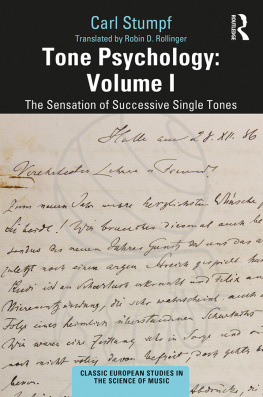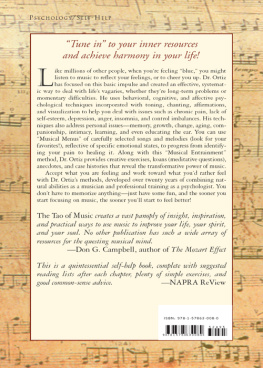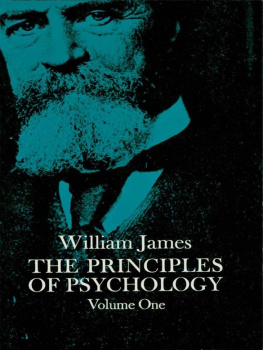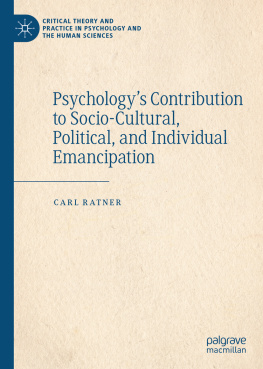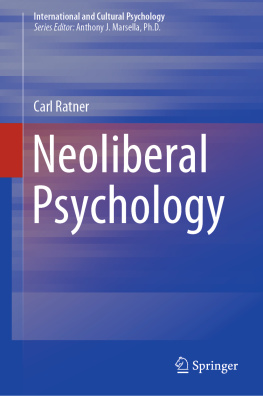Tone Psychology: Volume I
Carl Stumpf (18481936) was a German philosopher and psychologist and a visionary and important academic. During his lifetime, he ranked among the most prominent scientists of his time. Stumpfs intention, as evident in his book, Tone Psychology, was to investigate the phenomenon of tone sensation in order to understand the general psychic functions and processes underlying the perception of sound and music. It could be argued that modern music psychology has lost or perhaps ignored the epistemological basis that Carl Stumpf developed in his Tone Psychology. To gain a confident psychological basis, the relevance of Stumpfs deliberations on music psychology cannot be overestimated. Analyses of the essence of tones, complex tones and sounds are fundamental topics for general psychology and epistemology. By the end of this two-volume work, Stumpf had established an epistemology of hearing.
The subject of Volume I is the sensation of successive single tones. Stumpf demonstrates that analysis leads to the realisation of a plurality (is there only one tone or are there several tones?), which is then followed by a comparison: an increase may be observed (one tone is higher than the other) or a similarity may be realised (both tones have the same pitch or the same loudness). With almost mathematical stringency, Stumpf developed a topology of tones. Volume II deals with the sensation of two simultaneous tones (musical intervals). The books are stimulating, rewarding and provocative and will appeal to music psychologists, music theorists, general psychologists, philosophers, epistemologists and neuroscientists.
Carl Stumpf (18481936) was a German philosopher and psychologist.
Classic European Studies in the Science of Music
Series Editor
John Sloboda
In 2010 The European Society for the Cognitive Sciences of Music (ESCOM) established a project to bring new, broader readerships to historically important European monographs previously only published in a language (or languages) other than English. The main criterion for inclusion in the series is that the work concerned should have made a major (and historically significant) contribution to theory or method for analysing and understanding the structure, organisation, and underlying psychological mechanisms of music, and should not have been previously published in high quality English translation.
Tone Psychology: Volume I
The Sensation of Successive Single Tones
Carl Stumpf, translated by Robin D. Rollinger
For more information about this series, please visit: www.routledge.com/music/series/CESSM
Translation commissioned and funded by the ESCOM Irne Delige Translation Fund, a fund of the King Baudouin Foundation, Belgium.

Tone Psychology: Volume I
The Sensation of Successive Single Tones
Carl Stumpf
Translated by Robin D. Rollinger

First published 2020
by Routledge
2 Park Square, Milton Park, Abingdon, Oxon OX14 4RN
and by Routledge
52 Vanderbilt Avenue, New York, NY 10017
Routledge is an imprint of the Taylor & Francis Group, an informa business
2020 Carl Stumpf
The right of Carl Stumpf to be identified as author of this work has been asserted by them in accordance with sections 77 and 78 of the Copyright, Designs and Patents Act 1988.
All rights reserved. No part of this book may be reprinted or reproduced or utilised in any form or by any electronic, mechanical, or other means, now known or hereafter invented, including photocopying and recording, or in any information storage or retrieval system, without permission in writing from the publishers.
Trademark notice: Product or corporate names may be trademarks or registered trademarks, and are used only for identification and explanation without intent to infringe.
British Library Cataloguing-in-Publication Data
A catalogue record for this book is available from the British Library
Library of Congress Cataloging-in-Publication Data
A catalog record for this book has been requested
ISBN: 978-1-4724-3523-1 (hbk)
ISBN: 978-1-315-55087-9 (ebk)
Typeset in Times New Roman
by Apex CoVantage, LLC
For my dear parents
Contents of the First Volume
MARGRET KAISER-EL-SAFTI
C. STUMPF
Part I
Tonal judgements
1. Distinction of judgement from mere sensation. Definitions. 2. Critique of the theory of relativity.
14. Objective reliability. Two classes of judgements with regard to this. Absolute and relative reliability. 5. Most general factors of objective reliability; sensitivity and subjective reliability. Two kinds of illusion. Threshold of judgement. Unsolvable errors; unnoticeable sensations. Factors of subjective reliability. Polemics.
Special remarks on the measurement of sensitivity. Metric theory of judgement and psychophysics. Psychophysical method. Four distinctions. Four classes of experiment. Fechners Revision.
1. Nature, causes, effects of attention. Measurement. 2. Practice a) of the faculty of presentation (memory), b) of attention. 3. General course of practice. Maximum. Co-practice. Vantage point not in the organ. 4. Fatigue of sensation and of attention.
1. Mediating sensory judgement. Not an unconscious inference. Experiential judgement. Illusions. Different kinds of coexistence of features on which mediating judgements are based. 2. Transferred judgement. Likewise experiential judgement. Nativism and empiricism.
1. Judging according to four basic relations. General remarks about this. The relations immanent to sensations. Judgements of first and higher order. Does the act of comparison have a physical side? Is it an activity or a passive event? 2. A. Analysis = noticing of a plurality? B. Comparison = noticing of an increase. C. Comparison = noticing of similarities. Equality as extreme similarity. Multiple similarity: of complexes, of simples. Relation to the concept of increase. D. Comparison = noticing of fusions.
1. Broadest concept of distance = Degree of Dissimilarity. Possibility of judgements about distances. Must we present the transition in the estimation of a distance? Reliability of such judgements. 2. Judgements that presuppose a standpoint; spatial and temporal judgements as examples.
1. Tonal pitch = quality. Tones as a sum of absolute qualities. 2. Analysis. 3. Judgement about equality. Discernment of absolute tonal pitches. 4. Judgements about which tone is higher. Relation of increase? 5. Judgements about similarity (distance) and the resulting knowledge concerning the tonal realm. 6. Whether the judgements considered under 4 are also reducible to these. 7. So-called sensation of transition. 8. Parallelism of tones and numbers of vibrations.
1. Whether muscular sensations of the larynx are an indispensable criterion. Feelings of innervation. 2. Muscular sensations of the ear. 3. Unconscious knowledge of location. 4. On seeking out mediating criteria. 5. Parallels with the theory of space. 6. Real participation of mediating criteria.
In what sense is outward and inward infinity and continuity to be ascribed to tonal sensations or at least to tonal presentations?
1. Spatial symbols in the case of tones. 2. Overview of the expressions for the tonal differences in ancient and modern Languages. 34. Presence of spatial symbols in consciousness. 5. Looking for features that change in parallel with tonal qualities. 6. Explanation of the symbolism.

